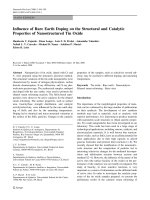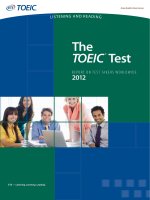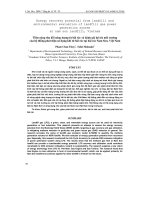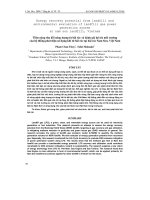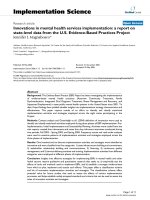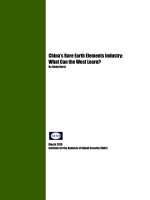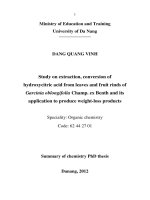Report on Rare Earth Elements from Coal and Coal Byproducts
Bạn đang xem bản rút gọn của tài liệu. Xem và tải ngay bản đầy đủ của tài liệu tại đây (2.95 MB, 49 trang )
Report on Rare
Earth Elements
from Coal and Coal
Byproducts
Report to Congress
January 2017
United States Department of Energy
Washington, DC 20585
Message from the Secretary
I am pleased to submit the enclosed report, Rare Earth Elements from Coal and Coal Byproducts.
This report outlines the assessment and analysis of the feasibility of economically recovering rare
earth elements from coal and coal byproduct streams such as fly ash, coal refuse, and aqueous
effluents.
This report was prepared by the Department of Energy, Office of Fossil Energy (FE), National Energy
Technology Laboratory (NETL) in response to an Explanatory Statement introduced in the House of
Representatives in connection with the Consolidated Appropriations Act, 2014 (Public Law 113-76
(Jan. 17, 2014). 1 The assessment and analysis effort was led by FE/NETL and conducted in
collaboration with industry, academia, and NETL’s Office of Research and Development (ORD). In
addition, the assessment and analysis was informed by industry, academia, and national laboratory
responses to the DOE Request for Information (RFI) for DE-FOA-0001202. The results of this
assessment and analysis have been made publicly available through />This report is being provided to the following Members of Congress:
The Honorable Joseph R. Biden, Jr.
President of the Senate
The Honorable Paul Ryan
Speaker of the House of Representatives
The Honorable Thad Cochran
Chairman, Committee on Appropriations
The Honorable Harold Rogers
Chairman, Committee on Appropriations
• The Honorable Barbara Mikulski
Vice Chairman, Committee on Appropriations
•
The Honorable Nita Lowey
Ranking Member, Committee on Appropriations
•
The Honorable Mike Simpson
Chairman, Subcommittee on Energy and Water Development
1
Explanatory Statement Introduced by Mr. Rogers of Kentucky, Chairman of the House Committee on Appropriations
Regarding the House Amendment to the Senate Amendment on H.R. 3547, Consolidated Appropriations Act, 2014, 160
Cong Rec H 475 at H 877 (January 15, 2014).
•
The Honorable Marcy Kaptur
Ranking Member, Subcommittee on Energy and Water Development
• The Honorable Lamar Alexander
Chairman, Subcommittee on Energy and Water Development
•
The Honorable Dianne Feinstein
Ranking Member, Subcommittee on Energy and Water Development
If you need additional information, please contact me or Christopher King, Acting Assistant
Secretary, Office of Congressional and Intergovernmental Affa irs, at (202) 586-5450.
Sincerely,
~
Ernest J. Moniz
Enclosure
Department of Energy | January 2017
Executive Summary
In response to an Explanatory Statement introduced in the House of Representatives in
connection with the Consolidated Appropriations Act, 2014 (Public Law 113-76 (Jan. 17, 2014),
the Department of Energy, National Energy Technology Laboratory (DOE/NETL), has performed an
assessment and analysis of the feasibility of economically recovering rare earth elements from
coal and coal byproduct streams such as fly ash, coal refuse, and aqueous effluents. Consistent
with the Explanatory Statement, this report presents the results of DOE/NETL’s assessment and
analysis, to the Committees on Appropriations of the House of Representatives and the Senate.
As suggested in the explanatory statement to the FY 2014 appropriations bill, DOE’s Office of
Fossil Energy (FE) explored the potential of coal and coal byproducts as viable sources of Rare
Earth Elements (REE). A series of activities to assess REE resources associated with major coal
basins in the U.S. were conducted. Over 1800 samples, representing approximately 30,000
individual REE analyses, were taken from various sources. Through both literature surveys and
testing samples from U.S. mining operations, a preliminary reserve base has been established in
two key coal-producing regions in the U.S. While the global REE market demand is expected to
remain on the order of 100,000 tonnes per year, these two regions alone in the U.S. have
potential reserves in the millions of tonnes.
Data have been generated by university mineral processing laboratories regarding the potential
for commercial mineral separation processes to produce REE concentrates from these materials.
Based on these results, preliminary economic analyses are underway, indicating the need for cost
improvements. These results suggest that the key to unlocking this potential reserve base for
economic U.S. REE production from coal and coal byproducts is the improvement of separation
technologies. In turn, research and development in this area can provide this expansion in the
U.S. REE reserve base.
The pathway toward economic recovery of REEs, from coal and coal byproducts, requires:
1. Continue identification of domestic sources of coal and coal byproducts with the highest
known concentration of REEs.
2. Conduct research to better understand the form and structure of REEs in coal and coal
byproducts. This will support the design of alternative separation technologies.
3. Design, development, and testing of alternative separation technologies to recover mixed
REEs from coal and coal byproducts for downstream processing and purification of
individual elements by REE refineries.
Report on Rare Earth Elements from Coal and Coal Byproducts | Page i
Department of Energy | January 2017
.
Report on Rare Earth Elements
from Coal and Coal Byproducts
TABLE OF CONTENTS
I. LEGISLATIVE REPORT LANGUAGE ........................................................................................................ 1
II. ASSESSMENT AND ANALYSIS .................................................................................................................. 2
Overview ............................................................................................................................................. 2
Current Market ..................................................................................................................................... 2
Introduction ......................................................................................................................................... 2
Value Chain .......................................................................................................................................... 4
Supply/Demand Balance ................................................................................................................ 6
Projected Market ............................................................................................................................... 7
Future Supply ...................................................................................................................................... 7
Future Demand ................................................................................................................................... 7
Additional Activities Addressing Supply .................................................................................. 8
Opportunities and Challenges Associated with Producing REEs from Domestic
Coal and Coal Byproduct Streams .............................................................................................. 8
Analysis of REEs in Coal and Coal Byproducts ...................................................................... 11
Introduction ...................................................................................................................................... 11
REE Sampling and Analysis Effort............................................................................................ 11
REE Resource Evaluation and Estimation ............................................................................ 11
REE Partitioning: Production .................................................................................................... 16
REE Partitioning: Processing .................................................................................................... 16
REE Partitioning: Utilization ..................................................................................................... 19
Technology Assessment................................................................................................................ 21
Introduction ...................................................................................................................................... 21
REE Mineralogy ............................................................................................................................... 22
Report on Rare Earth Elements from Coal and Coal Byproducts | Page ii
Department of Energy | January 2017
Traditional Rare Earth Processing Technology .................................................................. 23
Coal Beneficiation Processes Parallel REE Size Reduction and Separation ............. 24
Recovery from Fly Ash and Bottom Ash ................................................................................ 25
Aqueous Effluents........................................................................................................................... 26
Tangential Technology Development ..................................................................................... 27
Advanced Sensing, Detection, and Control ........................................................................... 27
III. ECONOMIC ASSESSMENT ....................................................................................................................... 30
IV. TECHNICAL CHALLENGES TO RECOVERING RARE EARTH ELEMENTS FROM THESE
DOMESTIC RESOURCES AND REQUIREMENTS FOR ADDRESSING THEM ........................... 35
V. CONCLUSION ............................................................................................................................................... 37
VI. APPENDIX A: DOE/NETL RARE EARTH ELEMENT SAMPLING METHODOLOGY ...... 38
REE Sampling and Analysis Effort ............................................................................................. 38
REE Sampling Program Methodology ...................................................................................... 38
ASTM Method D6357 ...................................................................................................................... 39
REE Resource Evaluation and Estimation .............................................................................. 39
VII. WORKS CITED ......................................................................................................................................... 41
Report on Rare Earth Elements from Coal and Coal Byproducts | Page iii
Department of Energy | January 2017
I.
LEGISLATIVE REPORT LANGUAGE
This report responds to an Explanatory Statement Introduced by Mr. Rogers of Kentucky, Chairman
of the House Committee on Appropriations in connection with the Consolidated Appropriations
Act, 2014. The Explanatory Statement provides:
Within NETL Coal Research and Development, the agreement includes $15,000,000
to perform an assessment and analysis of the feasibility of economically recovering
rare earth elements from coal and coal byproduct streams, such as fly ash, coal
refuse, and aqueous effluents. The Department is directed to report its findings and,
if determined feasible, to outline a multi-year research and development program
for recovering rare earth elements from coal and coal byproduct streams to the
Committees on Appropriations of the House of Representatives and the Senate not
later than 12 months after enactment of this Act.
In accordance with the Explanatory Statement, this Report discusses the relevant assessment and
analysis of REEs in coal and coal byproducts performed by DOE/FE and NETL. DOE has drawn on a
number of U.S. government, industry, academic, and research organization sources, and has
included relevant information from respondents to an NETL Request for Information.
Report on Rare Earth Elements from Coal and Coal Byproducts | Page 1
Department of Energy | January 2017
II. ASSESSMENT AND ANALYSIS
The REE value chain comprises
many recovery and processing
steps to produce high purity
rare earth oxides that are
subsequently offered for sale
in the global marketplace.
Few sources of REEs are in
commercial operation today
although approximately 25
new REE production projects
are currently at different
stages of pre-production
development.
Overview
While comprising just 17 elements of the periodic table, the
group known as rare earth elements (REEs) provides
significant value to our national security, energy
independence, environmental future, and economic
growth. Currently greater than 90 percent of the world’s
REE production capacity is controlled by China (DiLallo,
2014).
The World Trade Organization’s recent report regarding
China’s actions related to the price and supply of certain
REEs (World Trade Organization, 2014) and the creation of
the U.S. DOE’s Critical Materials Institute funded in part by
DOE’s Office of Energy Efficiency and Renewable Energy provide evidence of the need for a new
REE supply chain. As the pursuit of current and developing technologies in military, energy, and
medical fields continues to expand, so does the need for a reliable and affordable domestic supply
of REEs (Blunt, 2014). By 2022, however, China’s market share of REE production is anticipated to
fall from 95% to 46% with around 25 new REE production projects under development, including 2
in the U.S. (Visiongain, 2012).
A recent analysis of the economic importance of the REE industry in the U.S. (American Chemistry
Council, 2014) indicated that:
•
•
•
•
Intermediate products (magnets, catalysts, metallurgical additives, polishing powders, glass
additives, ceramics, and batteries) delivered $39.2 billion in revenue.
Intermediate products created 101,800 jobs generating $6.1 billion in payroll.
End-market products/technologies (health care, hybrid electric vehicles, lighting, communication systems, audio equipment, defense technologies, optics, oil refining, and wind power)
delivered $259.6 billion in revenue.
End-market products/technologies created 433,500 jobs generating $27.3 billion in payroll.
Current Market
Introduction
REEs are found throughout the earth’s crust but most often occur in low concentrations. They are
not found in isolated form but in a variety of minerals where, in most cases, they exist in
concentrations too small for economical extraction. The REEs (as shown in Figure 1) are:
lanthanum (La), cerium (Ce), praseodymium (Pr), neodymium (Nd), promethium (Pm), samarium
Report on Rare Earth Elements from Coal and Coal Byproducts | Page 2
Department of Energy | January 2017
(Sm), europium (Eu), gadolinium (Gd), terbium (Tb), dysprosium (Dy), holmium (Ho), erbium (Er),
thulium (Tm), ytterbium (Yb), and lutetium (Lu). The rare earths are also often considered to
include the metals scandium (Sc) and yttrium (Y).
Figure 1. Periodic Table Depicting Heavy and Light REEs
Report on Rare Earth Elements from Coal and Coal Byproducts | Page 3
Department of Energy | January 2017
Value Chain
The REE value chain shown in Figure 2 is process-intense. The REE value chain begins with
exploration and mining. Once the ore has been mined, it is typically crushed and milled into a finer
concentrate, which is further processed to separate REE-bearing minerals (such as bastnaesite).
The next phase in the value chain is separation and purification of REE-bearing minerals into their
pure oxide form, rare earth oxide. Rare earth oxides can be standalone products; however, market
demand dictates their conversion into metals. Rare earth metals are very soft and have specific
chemical properties and end uses; they can be processed into alloys by mixing two or more
elements in order to create harder and stronger final products for additional end uses.
Figure 2. REE Value Chain
Supply
The market for REE has been increasing since they were first mined in the mid-1900s. Historically,
the U.S. has had a large market share, being the largest producer of REEs from the 1960s to the
1980s. China began production in the 1980s and by 1988 secured the position of the world’s
leading REE producer. In 2011, global production of REEs was approximately 132,000 metric tons
(MT)—95 percent of which was supplied by China (Visiongain, 2012).
Report on Rare Earth Elements from Coal and Coal Byproducts | Page 4
Department of Energy | January 2017
Within the U.S., Molycorp actively mined rare earths at its Mountain Pass, California, site from the
1960s to the 1980s. During that time, the company was the world’s major producer of REEs due to
the mine’s higher-grade deposits and low production costs combined with a rapid increase in global
demand for REEs. Following a more recent restart by a new corporation formed in 2010, the
Mountain Pass operation was again idled in 2015 due to bankruptcy.
China has the world’s largest known rare earth deposit—the Bayan Obo deposit—holding over 48
million MT of REEs. China has controlled the global market throughout the majority of the last 30
years (Visiongain, 2012) (Blakely, Cooter, Khaitan, Sincer, & Williams, 2012).
Demand
In 2013 global annual demand for REEs was approximately 125,000 MT, with the United States
consuming approximately 18,100 MT. Specific end uses of REEs include developing technologies in
the communications, electronics, and military weapons markets. Examples are shown in Tables 1a
and 1b.
Table 1a. End Uses for Light REEs
Light Rare
Earths
Scandium
Lanthanum
Cerium
Praseodymium
Neodymium
Promethium
Samarium
Europium
Major End-Use
TVs, fluorescent and energy-saving lamps
hybrid engines, metal alloys
catalysts, metal alloys
Magnets
catalysts, hard drives in laptops, headphones, hybrid engines
watches, pacemakers
Magnets
red color for television, computer screens
Table 1b. End Uses for Heavy REEs
Heavy Rare
Earths
Terbium
Dysprosium
Erbium
Yttrium
Holmium
Thulium
Lutetium
Ytterbium
Gadolinium
Major End-Use
phosphors, permanent magnets
permanent magnets, hybrid engines
phosphors
red color, fluorescent lamps, ceramics, metal alloy agent
glass coloring, lasers
medical x-ray units
petroleum catalysts
lasers, steel alloys
magnets
Report on Rare Earth Elements from Coal and Coal Byproducts | Page 5
Department of Energy | January 2017
Supply/Demand Balance
The supply/demand relationships for individual REEs, among other topics, were presented in a
paper by a group at the Massachusetts Institute of Technology in 2012 (Alonso, et al., 2012).
Several cases—from a business-as-usual scenario to a revolutionary demand scenario—were
developed that tracked the technology forecasts in the International Energy Agency’s Blue Map
Greenhouse Gas scenario that would drive demand for individual REEs, including all five REEs
identified by DOE as critical, as shown in Figure 3 (Department of Energy, 2011). The study
indicated that the supply of these critical REEs would likely be subject to shortages between now
and 2035 under all five of the identified scenarios, which include increased use of wind energy,
electric vehicles, etc.
Figure 3. Medium Term (2015 – 2025) Criticality Matrix
(Department of Energy, 2011)
Report on Rare Earth Elements from Coal and Coal Byproducts | Page 6
Department of Energy | January 2017
Projected Market
Future Supply
In 2011, there were over 400 REE production projects in
various stages of implementation worldwide. More
recently, market conditions have resulted in many of these
projects being cancelled or put on hold. Pending successful
project development, some projects could be in production
by 2022, including two in the U.S. Should these projects
result in additional REE production, some supply and price
stabilization may result.
A number of other projects focusing on co-production of
REEs and other valuable minerals are being pursued (for
example, the Eco Ridge mine and Nechalacho projects, both
in Canada). The average REE concentration is low (0.15 and
1.3 percent, respectively) in these two projects, but the coproduction opportunities and the composition of the
REEs—favoring REEs in high demand for the foreseeable
future—support continued development. Co-production,
as would occur if coal, alumina, and other minor
constituents having commercial value were produced, is
often cited as a far more secure path toward developing
sources of REEs (Streetwise Reports, 2013).
Global market forecasts
suggest some REE supply and
price stabilization, with the
majority of LREEs being in
ample supply and HREEs
(high-value) remaining in
limited supply.
Many new projects focused
on diversifying supply are in
various stages of
implementation, but new
efforts to purify and refine
REEs are limited.
Domestic and international
activities have been initiated
to address supply concerns
and reduce the
environmental impact of
current processing
operations.
Global production of LREEs is expected to increase from
122,000 MT in 2011 to 346,000 MT in 2022, and production
of HREEs is expected to grow from 13,000 MT in 2012 to 46,000 MT in 2022. A supply surplus of
many LREEs and a shortage of HREEs are expected. HREEs accounted for 9.8 percent of total REE
production in 2011 (Visiongain, 2012).
Adequate supply is only a part of the solution to any REE supply shortfall. Additional processing,
refining, and manufacturing capacity is necessary to meet growing demand (Humphries, 2013).
Future Demand
Multiple research and industry sources have projected that global demand for REEs will increase
over the next 10 years, with an ample supply of LREEs but a limited supply of HREEs being available
(Visiongain, 2012) (Kingsnorth, 2011) (Hatch, Gareth P). Demand is expected to be driven by
growth in the technology and clean energy markets. In particular, growth in green technologies
such as wind turbines, which use permanent magnets, is expected to push REE consumption higher
(Visiongain, 2012).
Report on Rare Earth Elements from Coal and Coal Byproducts | Page 7
Department of Energy | January 2017
Individual REEs have variable supply and demand profiles and are found in varying proportions at
mining sites. Heavy REEs, in particular, are found in smaller quantities, are more difficult to extract,
and require more intensive processing for purification. As a result, they are more expensive from
a value-chain perspective. .
Additional Activities Addressing Supply
Nations are investing in REE research, developing REE deposits, and evaluating facilities to extract
REEs from native ore. Organizations formed to explore solutions to increase supply and reduce
demand include: (1) DOE’s Critical Materials Institute, (2) the Rare Earth Technology Alliance, an
initiative of the American Chemistry Council (3) Australia's Commonwealth Scientific and Industrial
Research Organization, (4) Japan and Vietnam’s joint Rare Earth Research and Technology Transfer
Centre, (5) the Canadian Rare Earth Elements Network, and (6) the European Rare Earths
Competency Network.
Opportunities and Challenges Associated with Producing REEs from
Domestic Coal and Coal Byproduct Streams
Coal and coal byproducts are a potential source of REEs, particularly HREEs. While the
concentration of total REEs in coal and coal byproducts is generally much lower relative to deposits
that currently serve as commercial supply sources of
REEs, the concentration of HREEs may be comparable to
The strong global interest in
that found in current commercial sources and can be
developing an additional REE
greater than that found in major sources of LREEs.
supply creates an investment
However, the challenges associated with extraction
opportunity for commercial firms
from such feedstocks are significant.
The mineralogy and distribution of the REEs in coal and
coal byproducts will pose challenges for any recovery
and separation concept, including those involving
physical, chemical, and other more novel separation
technologies. Limited data developed during this study
were used to identify promising paths that can be
applied to different source streams within the coal value
chain to concentrate the REEs.
seeking REEs recovered from coal
and coal byproducts to find
competitive entry points into the
REE global value chain.
REEs present in coal-based
materials currently being mined for
coal production represent potential
savings when compared to
production of virgin ore in a mine
dedicated solely to REE recovery.
Numerous scientific investigations have identified coal
The core challenges with REE
as containing potentially significant quantities of REEs.
recovery from coal and coal
Both coal processing refuse and ash residues have
byproducts center on the large
received attention for the economic value of the REEs
volume of material that must be
they might contain (Coal Ash: A Resource for Rare Earth
processed to recover REEs.
and Strategic Elements, 2013). Thus, the potential
opportunities for recovering REEs from coal and coal
byproducts are twofold: REEs are present in materials that are already being produced. Certain coal
Report on Rare Earth Elements from Coal and Coal Byproducts | Page 8
Department of Energy | January 2017
and coal byproducts have elevated concentrations of HREEs—which are lowest in supply, rank high
in criticality and price, and are projected to increase in demand—making them potentially attractive
targets for REE recovery despite their low composite REE concentrations. The REEs found in coal
often exhibit a compositional distribution of those REEs that would command a higher basket price
than would be found for more conventional and well-recognized ore bodies. Basket price can be
used as a rough tool to compare the compositional distribution of REE-bearing ores based on the
current relative value of each element or oxide as a pure—nearly 100 percent pure—commodity.
DOE/NETL performed an assessment of the amounts of REEs that are likely to be found in coal
deposits and the mineral matter—particularly the clays—associated with these deposits. The initial
resource estimates indicate that 6 million MT of REEs could potentially be produced from
recoverable coal reserves in select western state coal basins in Montana, Wyoming, Colorado, Utah,
New Mexico, and Arizona. Similar estimates indicate that 4.9 million MT are potentially available
from among the coal deposits found in Pennsylvania, West Virginia, Kentucky, and Virginia. These
estimates represent total resources, with REE contents in associated mineral matter over a cutoff
grade of 500 parts per million, and are based on estimates of recoverable coal reserves in these
regions found elsewhere (Administration U. E., 2012). The actual amounts that could be recovered
would be a function of mining practices and the economics of recovery from operations actively
producing, processing, and utilizing newly mined coal. However, given (as previously cited on page
7 of this report) the forecast REE demand in the hundreds of thousands of tonnes per year, this
technically recoverable resource of over 10 million tonnes in two of the U.S. coal-producing regions
is substantial. In addition, there is potential additional tonnage in coal ash and coal mine
refuse/reject.
Further, the REEs are typically associated with clays (small particles of clay trapped in the organic
phase or larger partings and roof or floor material rich in clay minerals). These materials can be
sources of both alumina (as the clay mineral can be described as hydrous aluminosilicates) and
other valuable trace metals.
As a result, opportunities to recover REEs from coal and coal byproducts appear possible, but
require more information and technology development to create pathways toward both improved
economics and environmental footprint. New processing systems must incorporate steps to
recover, separate, and/or refine REEs without generating additional unwanted products or
negative environmental impacts. These advances may also facilitate recovery of REEs from large
volumes of fly and bottom ash as well as other spent and low-concentration sources. Moreover,
the co-production of REEs with other useful materials available in coal and coal-byproduct sources
offers the potential to further enhance the economic viability of REE recovery from coal and coal
byproducts.
Figure 4 provides a conceptual schematic of the coal value chain as it relates to opportunities to
recover REEs. The concentrations of REEs stemming from the production, processing, and
utilization processes shown in the figure below vary greatly depending on specific source.
Data generated to date through this project suggest that the most significant opportunities are
associated with mining byproducts (pit cleanings and water resources), as well as preparation
Report on Rare Earth Elements from Coal and Coal Byproducts | Page 9
Department of Energy | January 2017
refuse. In Figure 4, these categories are shown in the “production” and “processing” portions of
the diagram, respectively.
Figure 4. Many opportunities for REE recovery span the coal value chain
Report on Rare Earth Elements from Coal and Coal Byproducts | Page 10
Department of Energy | January 2017
Analysis of REEs in Coal and Coal Byproducts
Introduction
The presence of REEs in coal and coal byproducts has
been known for many years (Bragg et al., 2014).
Additional sampling and analysis within this (DOE’s) study
were designed to better characterize the presence of
REEs in coal resources at active coal mines and
preparation plants (the latter comprising the
“processing” portion of Figure 4), in aqueous effluents
from coal mining and preparation, and in combustion
byproducts (the “utilization” portion of Figure 4). Data
were also gathered for coal-derived refuse materials such
as fine coal refuse, coarse refuse, impounded fly ash and
bottom ash, and other related coal refuse.
Coal and coal byproducts are
a potential source of REEs,
but the concentration of REEs
is generally lower than that
present in commercial
deposits that currently supply
REEs.
Coal and coal byproducts
contain HREEs—which are least
prevalent, rank high in criticality and price, and are
projected to increase in
demand.
The complete results of the fieldwork are available at
This repository contains
data from a number of contributing organizations. More than 29,000 individual REE elemental
concentrations were determined from more than 1,820 grab samples. The samples were taken at
26 coal preparation plants, 18 coal combustion units (including pulverized coal-fired units, fluidized
bed units, and industrial stokers), and a number of coal mines. Core samples from state geological
surveys in six states are included. In addition, a series of separation tests were run. The most
significant results are summarized in the “Analysis of REEs in Coal and Coal Byproducts” and the
“Technology Assessment” sections of this report. DOE/NETL has prepared several scientific reports
on this topic for public release, including publication of peer-reviewed results.
REE Sampling and Analysis Effort
The study samples were collected from: (1) state geological surveys, (2) companies operating active
production and/or processing plants, (3) companies operating a variety of utilization facilities, and
(4) companies owning disposal sites (active and inactive). The sampling methodology, which
followed ASTM method D6357 (ASTM International) is detailed in Appendix A.
REE Resource Evaluation and Estimation
The resource estimates presented below were derived by statistical analysis of U.S. Geological
Survey (USGS) data (1997), (Bragg, et al.), and augmented by data taken during this study. This
effort focused on one sub-region in the eastern U.S. and one in the western U.S. A methodology
was developed using samples from both eastern and western states to assess REE content, both in
the coal-bearing, organic portion of the deposit and in likely REE-bearing minerals associated with
the coal. The assumptions made and methodology employed in developing the REE resource
estimates are outlined below.
Report on Rare Earth Elements from Coal and Coal Byproducts | Page 11
Department of Energy | January 2017
Estimates made during this study indicate that, at a minimum REE concentration of 500
parts per million (ppm) in coal mineral matter, 6 million MT of REEs could be recovered
from within the boundaries of the known coal reserves in select western state coal
basins in Montana, Wyoming, Colorado, Utah, New Mexico, and Arizona. Similar
calculations show that 4.9 million MT are available from within the boundaries of the
coal deposits found in Pennsylvania, West Virginia, Kentucky, and Virginia. These
estimates are based on total recoverable coal resources (Administration U. E., 2012).
The estimate assumed that essentially all of the REEs are associated with the clay minerals with
only minor amounts ion-exchanged into the organic phase. Some of the clays may be finely divided
and trapped within the organic portion that is preferentially separated as “clean coal” during the
preparation process. Because of the limited distribution and range of samples utilized in the study,
the REE estimates are believed to be conservative estimates of the possible REE resources available.
The maps below (Figures 5a, 5b, and 5c) overlay the calculated resources of REEs developed for
this study onto an outline of the major coal basins in the U.S. The resource estimates are provided
as tons of REEs per block (a “block” being a section one kilometer (km) by one km in surface area
and one meter in depth). These maps were developed based on the original USGS data accounting
for the full depth of the coal deposit and including associated clay and other mineral matter that
are treated as partings or benches and often discarded as refuse. The analysis then produced data
on the amount of REEs likely to be found in the full deposit (not just the portion that is
predominately coal). The overlay of the REE resource coincides with the general regions from
which samples were drawn. These resource maps also made use of other data related to known
faults and geologic features known to correlate to REE enrichment as shown on the map. A far
greater number of samples from the eastern coal regions were included in the USGS source
material. The USGS Coal Quality database originated in the 1970s and was updated most recently
in 1998. Some sourcing bias remains; in particular, the number of samples from the Gulf Coast
lignite region was small.
Report on Rare Earth Elements from Coal and Coal Byproducts | Page 12
Department of Energy | January 2017
Figure 5a. REEs in U.S. Coal. (a) Map of the continental U.S. (Alaska not analyzed).
Report on Rare Earth Elements from Coal and Coal Byproducts | Page 13
Department of Energy | January 2017
Figure 5b. REEs in U.S. Coal. (b) Map for Appalachian Region.
Report on Rare Earth Elements from Coal and Coal Byproducts | Page 14

